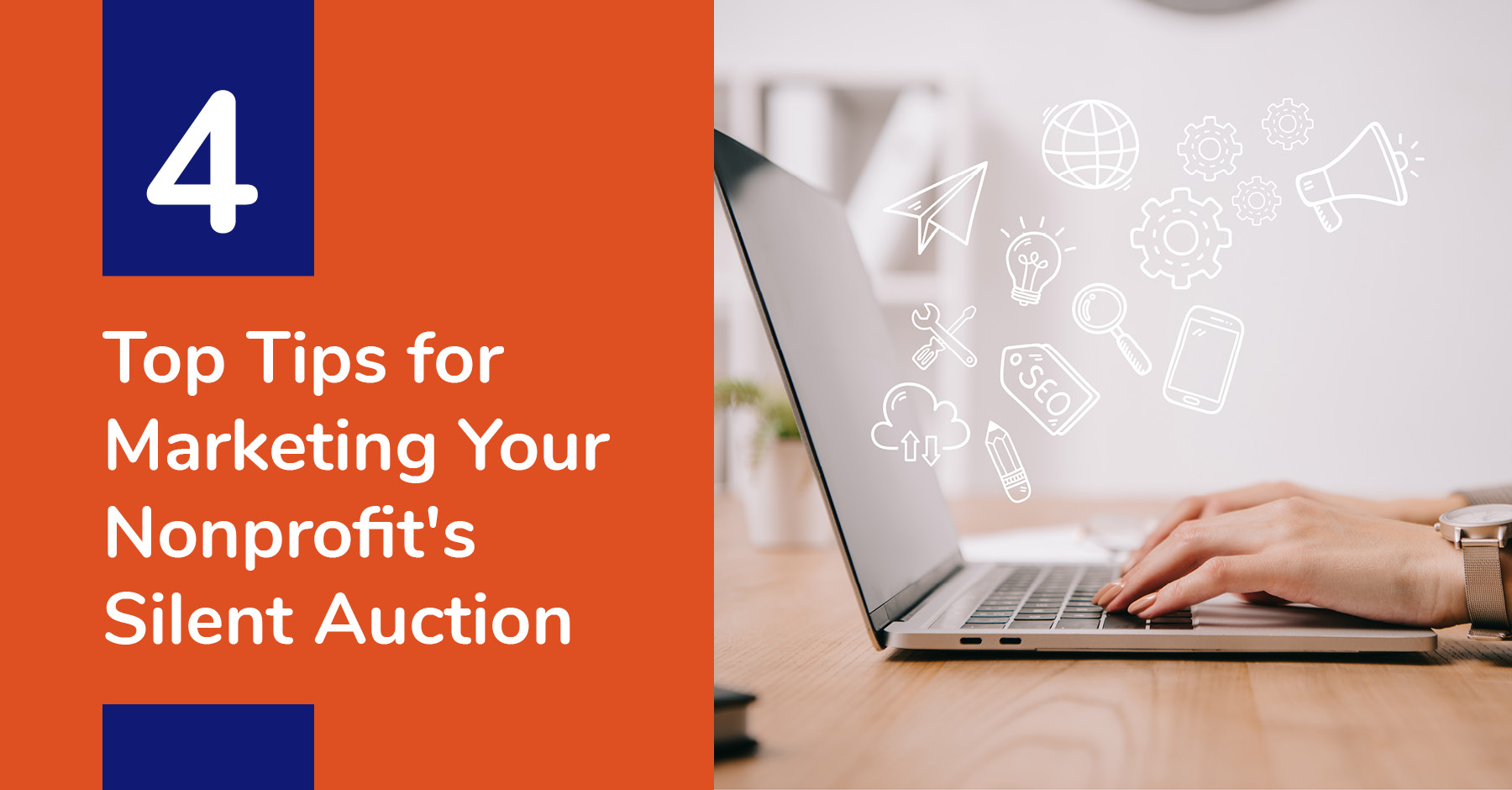4 Top Tips for Marketing Your Nonprofit’s Silent Auction

Silent auctions are popular nonprofit fundraising events for several reasons. They can be held in-person or online, and they can easily be paired with other events, which can range from a virtual golf tournament to a charity art exhibition.
Additionally, silent auctions are known for their auction item versatility. Your organization can procure a range of items based on your audience preferences to make sure the event appeals to their unique interests. That said, because silent auctions are so flexible, they are also simple to market.
In this short guide, we’ll walk through the four basic steps for marketing your next silent auction:
- Understand Your Audience
- Leverage Multiple Communication Channels
- Incorporate Your Nonprofit’s Branding
- Feature Your Auction Items in Marketing Materials
It can be helpful to turn to previous auction data to inform your marketing strategy. What previous silent auction item ideas caused heated bidding wars? How were these auction items marketed leading up to the event? Once you’ve consulted this data, it’s time to dive into preparing for this year’s silent auction. Let’s get started!
1. Understand Your Audience
Before you begin sending marketing materials, it’s helpful to define your audience as your donor engagement strategies will vary depending on your audience. Once you’ve researched who you’re trying to reach, you can then activate targeted messages that best align with them.
To get a full understanding of your audience, try segmenting them based on shared characteristics. These might include the following:
- Demographics: Age, location, family status, and employment type.
- Giving history: Average giving amount, frequency of gifts, recency of gifts, and estimated lifetime value to your organization.
- Past involvement: Volunteering history, previous event attendance, in-kind donations, and any other non-monetary contributions.
After you’ve nailed down these shared characteristics among your audience, decide which segments you’d like to prioritize. Then you can use your messaging to directly target those segments with their preferred communication types in mind.
For example, if you’d like to focus on inviting previous high-impact donors to your silent auction gala, you might send personalized handwritten invitations. On the other hand, if you’d like to prioritize inviting prospective donors, you might include testimonials and statistics from previous silent auction events to persuade them to attend.
2. Leverage Multiple Communication Channels
Using audience preferences as a starting point, you’ll need to launch a multi-channel marketing campaign. Leveraging several communication methods creates multiple touch points, allowing you to reach more supporters. It’s best to diversify your silent auction promotion across the following channels:
- Website. Using web design best practices, craft a dedicated landing page that offers comprehensive event information, registration instructions, and clear call to actions (CTAs) that direct visitors to sign up. Consider including additional links to relevant site pages for new or returning visitors to learn more about your organization.
- Social media. Post teasers and previews of your auction items across all of your organization’s social media profiles to get your audience excited about attending your event. Add countdowns, updates, and reminders regularly to keep your followers engaged.
- Email. Feature your silent auction event information in your email newsletter in addition to sending out dedicated email marketing blasts. Your email marketing campaign should include catchy titles, clear CTAs, and a tone of urgency and excitement to rally support.
- Direct mail. Use direct mail to work alongside digital marketing and include enticing printed materials and compelling narratives that showcase your event’s value. Direct mail can be especially effective for reaching audience demographics who are not actively engaged online.
By leveraging all of these marketing channels, your nonprofit can widen its reach and engage new audiences. Just remember to include clear registration instructions in all of your marketing communications. That way, you can lead visitors back to a dedicated web page to sign up or discover more information.
3. Incorporate Your Nonprofit’s Branding
To maintain consistency across communication channels, it’s essential to incorporate your nonprofit’s graphic design elements. Doing so will assure your audience of your nonprofit’s credibility and reduce any potential messaging confusion.
Make sure these elements of your organization’s brand are consistently represented:
- Nonprofit name and tagline. If your nonprofit goes by more than one organization name or has an abbreviated title, be sure to stick to one title in your communications. Your tagline should also be short and memorable. For example, UNICEF’s tagline, “For every child” zooms in on their mission to further child rights.
- Color scheme. Stick to the same color scheme on all of your marketing materials. Usually nonprofits use one bold primary color and a couple of accent colors to keep messaging simple and straightforward.
- Fonts. If you have already chosen a font family for your website, make sure to represent that family in your social media posts, newsletters, and other printed or digital materials. For reference, sans serif fonts typically work best to ensure brand recognizability and readability standards.
- Logo. Although you likely have several nonprofit logo iterations, it’s best to select one logo variation to include in your communications. Doing so will align all of your messaging and make the best use of your unique visual brand. You’ll also want to make sure your logo is compressed on digital file formats without losing any quality. To do this, you’ll need to opt for PNG or .SVG file formats.
As a starting point, Kwala’s guide to nonprofit branding suggests referencing your nonprofit brand kit to keep all elements aligned. This document summarizes your organization’s visual identity and acts as a source of truth for the above elements. It’s typically updated regularly and used by all team members to ensure consistency.
For instance, if your marketing team is unsure which colors to use for web or print communications, they can easily refer to the brand kit to discover the exact hex code for each color and adjust their communications accordingly.
4. Feature Your Auction Items In Your Marketing Materials
As the main attraction of your event, your auction items should have a prominent place in your marketing materials. When marketing for your silent auction, you’ll need to pay special attention to which items you’d like to highlight and how you’d like to represent them.
To excite your audience, market your auction items with:
- A catchy name. Winspire’s list of silent auction basket ideas suggests organizing your baskets around different themes with fun and memorable names. For instance, you might advertise a “garden in a box” basket complete with seeds, pots, gloves, and other gardening supplies to entice plant lovers.
- Clear photos and descriptions. Each auction item should have clear photos and a description to give your audience an idea of each item’s appeal. Experiences like a beach vacation getaway, for instance, could include photos and a description of that specific location’s unique attractions.
- Sponsor acknowledgments. Auction item marketing is also a great place to include a thank-you message to sponsors who have helped make your upcoming event a reality.
Although you do not need to include a full auction catalog, it’s still a good idea to highlight your best items through social media sneak peeks and behind-the-scenes teasers. Refer to your audience research to narrow which items you should spotlight based on which ones performed well in the past and your supporters’ preferences.
Successfully marketing your silent auction involves leveraging what you know about your target audience and aligning your communication to align with their interests and preferences. For an extra incentive, you might also consider encouraging early bidding on prized items with additional perks like bonus bids. Happy fundraising!


